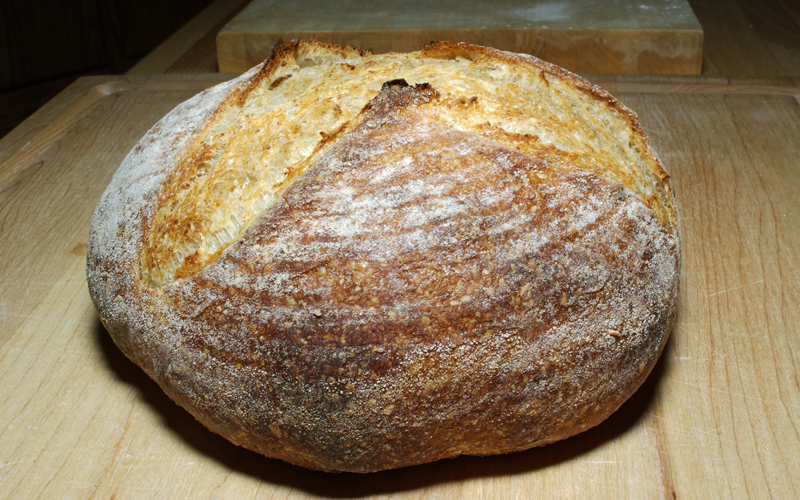
Another twist on steaming
David Snyder (dmsnyder) has convinced me pre-steaming is beneficial, but I've still been uncertain I'm generating enough steam, considering my oven door is not an airtight fit, and the convection fan blows some of the steam out around the door. So, today, I tried a new way to generate steam. I saw it recommended in Hamelman's Bread, but I ignored it happy as I was, at the time, generating steam with pre-heated lava rocks. It was only when David wrote of his experience pre-steaming his oven that I started reexamining the details of my steaming practice.
My wife's dog/horse treat baking (see blog http://www.thefreshloaf.com/node/13862/baking-going-dogs-and-horses-too) gave me a clue. Here pet snack recipe is packed with fresh shredded carrots, resulting in a very wet "dough". Watching her open the oven door while baking three half-sheet pans full I saw a large amount of steam (water vapor, really) pour out of the oven.
Today I fitted a half-baking sheet with a terrycloth shop towel that covered its bottom. Five minutes before I put in the first loaf I poured a cup of hot tap water onto the towel. It was enough to soak it thuroughly, but there was no free standing water. I placed the pan on the lowest shelf. As usual, I also covered the oven's top vent with a folded towel. Before five minutes were up I saw water vapor escaping at the bottom of the door where its sealing gasket's ends meet. I've never seen that before, although I was previously convinced steam was escaping.
When I placed the loaf, the oven was visably full of water vapor; nevertheless, I added another 1/2 cup of water to the towel. At ten minutes I reduced the oven temperature, and removed the sheetpan, and uncovered the oven vent.; for safety reasons I'd never attempt to remove the lava rocks. Whatever water vapor remained in the oven I'm certain disappated quickly. After the sheetpan and towel cooled I felt the towel. Its center was still damp, but the edges were dry, justifying the additonal 1/2 cup of water added.
Here's the visual results. I bake this sourdough (Vermont sourdough with a stiff levain) once every week. This loaf's oven spring is as good or better than any before now.
I'm going to adapt this method, at least for the near future. I think it's safer than splashing water into a pan of lava rock, all indications show it produces more steam, and it can be simply and safely removed to immediately stop the source of steam.
David G


Comments
the first 00:15 of baking are really important and steam is the trick. I tried pre-steaming, lava rocks, metal pan on the top/bottom ... but my 15 years old electric oven does not help me with steam because the temperature is not uniform (hot back, "cold" front); I think this is due to the top element that is incandescent in the back of the oven. So, the only thing I can do is to "build" another small oven in my ovent, that is: I bake on stone covered with a pre-heated terra-cotta clay pot. This is very effective, it trap steam, normalize temperature and protects the bread skin from the top element. After the first "critical" 00:15, oven spring reach the peak and I can finish uncovered.
Have you tried covered baking? I found it really easy and safe (I don't have to work with hot water and steam).
Giovanni
Currently I use a clay baker for round breads or the bottom of a deep enamel turkey roaster to cover my bread for the first half of baking.
This, IMHO, works better than most steaming techniques without the mess or danger. I get amazing oven spring, color, and crispness. The bread literally sings (crackling sound) when it comes out of the oven.
Some wood fire oven bakers steam their ovens by adding a pan or 'rolled damp' towels on a sheet pan. Rolling the towels might help retain more of the moisture and keep the towel from drying out on the ends and you wouldn't have to wet them after they are in the oven. I haven't tried this method in my wfo or indoor oven but I think if I were to try it I might just heat the dampened towels up in the microwave first rather than bother pouring hot water onto them before loading them onto a pan. I also turn the convection feature off when steaming.
Sylvia
I've also tried spraying / misting the inside of a tin foil roaster pan and then placing that over the baking bread for the first 10-15 minutes. The misting (using a home depot spray bottle filled with water) seems to give a boost to my breads.
I put the bread in - spray the inside of the foil pan with the water - and then place it over the bread.
IN thinking about your method - you could almost put a wet towel over a stainless steel collander and invert that over your bread? The towel wouldn't be dripping wet - just very damp - and the colander would most likely have to completely cover your bread while allowing room for oven spring. nice thing about that is that collanders come in all shapes and sizes.
hmmmmmmmmmmmm
thought provoking.
-susie
Interesting idea. I have had great success with boiling water on the heated pan. The thought of not having to take the extra steps, boiling the water, covering the glass on the oven door and being carefull to avoid the steam blast sounds good to me.
Betty